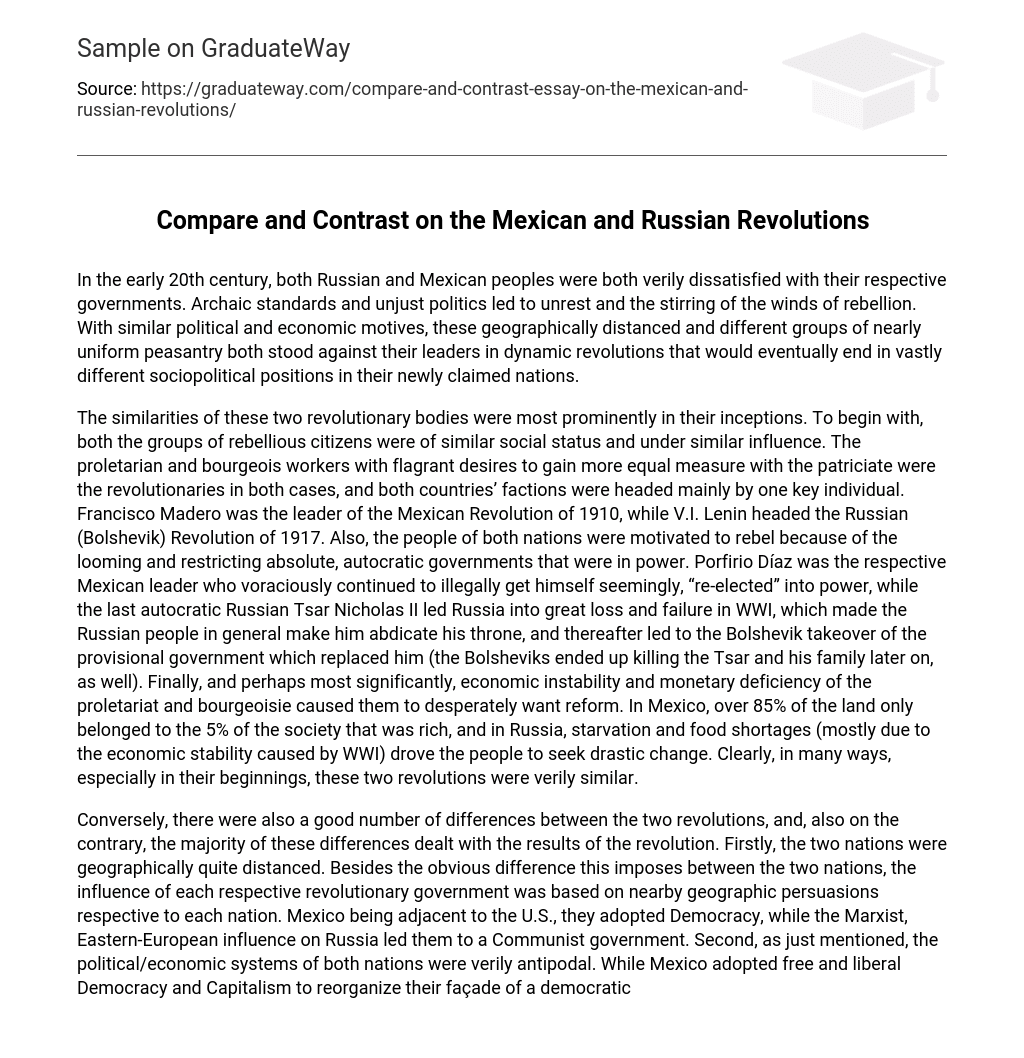In the early 20th century, both Russian and Mexican peoples were both verily dissatisfied with their respective governments. Archaic standards and unjust politics led to unrest and the stirring of the winds of rebellion. With similar political and economic motives, these geographically distanced and different groups of nearly uniform peasantry both stood against their leaders in dynamic revolutions that would eventually end in vastly different sociopolitical positions in their newly claimed nations.
The similarities of these two revolutionary bodies were most prominently in their inceptions. To begin with, both the groups of rebellious citizens were of similar social status and under similar influence. The proletarian and bourgeois workers with flagrant desires to gain more equal measure with the patriciate were the revolutionaries in both cases, and both countries’ factions were headed mainly by one key individual. Francisco Madero was the leader of the Mexican Revolution of 1910, while V.I. Lenin headed the Russian (Bolshevik) Revolution of 1917. Also, the people of both nations were motivated to rebel because of the looming and restricting absolute, autocratic governments that were in power. Porfirio Díaz was the respective Mexican leader who voraciously continued to illegally get himself seemingly, “re-elected” into power, while the last autocratic Russian Tsar Nicholas II led Russia into great loss and failure in WWI, which made the Russian people in general make him abdicate his throne, and thereafter led to the Bolshevik takeover of the provisional government which replaced him (the Bolsheviks ended up killing the Tsar and his family later on, as well). Finally, and perhaps most significantly, economic instability and monetary deficiency of the proletariat and bourgeoisie caused them to desperately want reform. In Mexico, over 85% of the land only belonged to the 5% of the society that was rich, and in Russia, starvation and food shortages (mostly due to the economic stability caused by WWI) drove the people to seek drastic change. Clearly, in many ways, especially in their beginnings, these two revolutions were verily similar.
Conversely, there were also a good number of differences between the two revolutions, and, also on the contrary, the majority of these differences dealt with the results of the revolution. Firstly, the two nations were geographically quite distanced. Besides the obvious difference this imposes between the two nations, the influence of each respective revolutionary government was based on nearby geographic persuasions respective to each nation. Mexico being adjacent to the U.S., they adopted Democracy, while the Marxist, Eastern-European influence on Russia led them to a Communist government. Second, as just mentioned, the political/economic systems of both nations were verily antipodal. While Mexico adopted free and liberal Democracy and Capitalism to reorganize their façade of a democratic government that was present under Díaz, V.I. Lenin incepted a New Economic Policy (the N.E.P.: an ever-so-slightly more liberal Communist economy) and Communist, completely equal and collectivist political ideals to revitalize Russian strength and nationalism in a new Russian era. Finally, a particularly notable difference between the two was their varying levels of post-revolutionary social stability. While Lenin’s N.E.P. and Communist reforms did not immediately or completely solve Russia’s problems, they did pave the road leading to eventual Russian supremacy and created a uniform bond of nationalism, pride, and fervor in the hearts of the members of the new Soviet Union (there were no major counterrevolutionary incidents after Bolshevik takeover, anyway…political squabbles and malevolence and censorship were to come under Stalin, but as far as socially, the Soviets remained Soviets until the fall of the Berlin Wall). In Mexico, however, counterrevolutionary Victoriano Huerta quickly usurped Madero in a coup d’état in 1913, and, with Madero’s death as an apparent martyr in the eyes of the revolutionary Mexicans, Huerta’s regime was also taken down by revolutionaries in support of and akin to Madero. This displays the much more stable social setting of post-revolutionary Russia in contrast to post-revolutionary Mexico. Plainly, the two revolutions also had a significant number of differences, as well, especially in their aftermaths.
Russian and Mexican plights were verily similar, but the actions they took after their victories were quite unlike. While both similar factions sought liberation from tyranny and economic distress, their differently-influenced cultures led them to choose equally different paths of reform after their revolutions were successful. The Bolsheviks adopted rigid Communism and acquired stone-faced, fervently nationalist dispositions, which, at the sacrifice of freedom, would end up being used to forge the Iron Curtain. Mexico adopted liberal Democracy, and their unbridled passion led even to quick counterrevolution, and frequent rebellion thereafter until peace was finally settled significantly later on. In truth, however, both nations’ people took up their own torches, and marched their way out of the darkness of autocracy into a future that was all their own.





